Convair C-131 Samaritan
The Convair C-131 Samaritan is an American twin-engined military transport produced from 1954 to 1956 by Convair. It is the military version of the Convair CV-240 family of airliners.[2]
| C-131 Samaritan R4Y / T-29 | |
|---|---|
| Convair C-131F Samaritan | |
| Role | Military transport |
| Manufacturer | Convair |
| First flight | 22 September 1949 |
| Introduction | 1950 |
| Retired | 1990 |
| Primary users | United States Air Force United States Navy Paraguayan Air Force |
| Number built | 512[1] |
| Developed from | Convair CV-240 |
Design and development
The design began life in a production requirement by American Airlines for a pressurized airliner to replace the classic Douglas DC-3. Convair's original design had two engines and 40 seats, and thus it was designated the CV-240. The first CV-240 flew on March 16, 1947, and production aircraft were first delivered to American on February 28, 1948. Seventy-five were delivered to American, with another fifty going to Western Airlines, Continental Airlines, Pan American Airways, KLM, Sabena, Swissair and Trans Australia Airlines.
Operational history
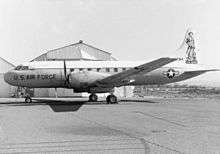
The CV-240/340/440 series was used by the United States Air Force (USAF) for medical evacuation and VIP transport and was designated as C-131 Samaritan. The first model Samaritan, the C-131A, was derived from the CV-240 model, and was delivered to the USAF in 1954.
The earlier trainer model, designated the T-29, was also based on the Convair 240 and was used to instruct USAF navigators for all USAF aircraft and those USN Naval Flight Officers (NFOs) selected to fly land-based naval aircraft. First deliveries to the USAF were made in 1950 followed by large production quantities until early 1955. The USAF and the USN operated T-29s in separate units at separate locations until 1976. In 1974, the USAF T-29s with the 323d Flying Training Wing (323 FTW) at Mather AFB, California began to be replaced by the Boeing 737-derived T-43. In 1975, the Navy retired all of its T-29s assigned to Training Squadron Twenty-Nine (VT-29) at NAS Corpus Christi, Texas, deactivated VT-29, and merged their advanced navigator training program for land-based NFOs with the Air Force's program at Mather AFB.
A planned bomber training version of the T-29 (designated T-32) was never built. The CV-340 model was used for most C-131Ds.
In addition to T-29 variants, the United States Navy used the Samaritan, initially designated as the R4Y until 1962, at which point the naval aircraft were also redesignated as C-131s.
Nearly all of the C-131s left the active USAF inventory in the late 1970s, but the U.S. Coast Guard operated the aircraft until 1983, while the Air National Guard and U.S. Navy units operated additional C-131 airframes, primarily as Operational Support Aircraft (OSA) for Air National Guard flying wings and as naval air station "station aircraft" until 1990. The C-131 was primarily replaced by the C-9 Nightingale in regular USAF service, with the Air National Guard replacing their OSA with C-130 Hercules aircraft and the Navy with C-12 Hurons.
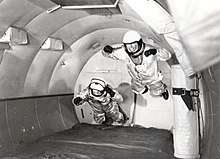
In 1959, a C-131 was the first aircraft to be used as a reduced-gravity aircraft or 'vomit comet', for astronaut training as part of Project Mercury.[3][4][5]
A Samaritan was the first aircraft used as a flying gunship testbed in mid-1963, in a program known as "Project Tailchaser".[6] A C-131B (AF Ser. No. 53-7820) was given a gunsight for the side window, but instead of guns it had cameras in the cargo area. Eventually the C-131 was ferried to Eglin AFB in Florida and a General Electric SUU-11A/A 7.62 mm Gatling-style Minigun was installed. Live ammunition was used and both over-water and overland tests were successful.[7]
Accidents and incidents
On 17 December 1960, a C-131D Samaritan crashed at Munich in what is the largest loss of life in an accident in the Bavarian capital. Shortly after takeoff one engine failed and the pilot tried to get back to Riem in heavy fog over Munich. Due to the limited visibility the aircraft struck the tip of St. Paul's church close to the Theresienwiese, and crashed onto a streetcar, killing all 20 people on board the plane, and 32 on the tram.[8]
On 8 February 2019, a C-131 operating Conquest Air Cargo Flight 504 from Nassau (Bahamas) to Miami Opa-Locka, FL (USA) lost power in both engines and ditched about 9 NM off the coast of Florida, breaking apart on touchdown. One of the two pilots on board was rescued and the other remained missing.[9]
Variants
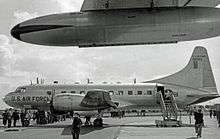
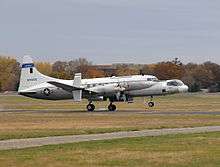
- C-131A
- Transport for United States Air Force based on Convair 240, capable of carrying 39 passengers on rearward facing seats or 20 stretchers and 7 seats. 26 built.[10]
- HC-131A
- Surplus C-131As transferred to the United States Coast Guard, 22 transferred.
- MC-131A
- Temporary designation used before 1962 when a C-131A was used for medivac duties with 27 stretchers.
- VC-131A
- Temporary designation used before 1962 when a C-131A was used as a staff transport.
- C-131B
- A hybrid Model 240/340 with seats for 48 passengers, 36 built.
- JC-131B
- C-131B converted for missile tracking, six conversions.
- NC-131B
- One C-131B used for permanent testing.
- VC-131B
- C-131B when used as a staff transport.
- YC-131C
- Two Model 340s flown with Alison 501D-13 engines.
- C-131D
- Military version of the Model 340 with seats for 44 passengers, 33 built.
- VC-131D
- C-131D when used as a staff transport.
- C-131E
- Electronic Countermeasures training version for Strategic Air Command (SAC), later designated TC-131E, 15 built and one conversion from C-131D, two transferred to United States Navy as R4Y-2.
- TC-131E
- C-131E redesignated.
- C-131F
- R4Y-1 redesignated.
- RC-131F
- Conversions for photo-mapping and survey, six conversions.
- VC-131F
- R4Y-1Z redesignated.
- C-131G
- R4Y-2 redesignated.
- EC-131G
- One C-131G modified as an electronics trainer.
- RC-131G
- One C-131G modified as an airways aid checking duties.
- VC-131G
- C-131G used as a staff transport.
- C-131H
- Other models converted to Model 580 turboprop standards.
- NC-131H
- One conversion with an extended nose incorporating a separate cockpit as a Total In-Flight Simulator. This aircraft was transferred to the National Museum of the United States Air Force at Wright-Patterson AFB, Ohio on November 7, 2008[11]
- R4Y-1
- United States Navy version of the Model 340 with 44 passenger seats, redesignated C-131F in 1962, 36 built.
- R4Y-1Z
- United States Navy staff transports, redesignated VC-131F in 1962, one built and conversions from R4Y-1.
- R4Y-2
- Two C-131Es transferred to the United States Navy, redesignated C-131G in 1962, an additional 13 cancelled.
- R4Y-2Q
- Projected radar countermeasures version of the R4Y-2, five cancelled
- R4Y-2S
- Projected United States Navy Anti-Submarine Warfare trainer version, 14 on order cancelled.
- XT-29
- Prototype military trainer version of the Model 240 for the United States Air Force, two built.
- T-29A
- Initial production version for navigator training, unpressurised cabin for 14 students, 46 built.
- VT-29A
- T-29As converted for staff transport.
- T-29B
- Pressurised version with room for 10 navigator and four radio operator students, 105 built.
- NT-29B
- One T-29B used for permanent testing.
- VT-29B
- T-29B converted for staff transport with seating for 29 or 32 passengers.
- T-29C
- T-29B with 2500hp Pratt & Whitney R-2800-29W engines, 119 built.
- AT-29C
- T-29C modified for airways checking duties, redesignated ET-29C in 1962.
- ET-29C
- AT-29C redesignated.
- VT-29C
- T-29C converted for staff transport.
- T-29D
- Bombardier training version of the T-29C with room for six students, 93 built.
- ET-29D
- Airways checking conversion of the T-29D.
- VT-29D
- Staff transport conversion of the T-29D.
- XT-29E
- Proposed turboprop version of T-29B, none built.
- YT-32
- Proposed bomber training version with transparent nose, none built.
Operators
- Paraguayan Air Force operated one former USAF Convair C-131D[12]
- United States Air Force operated T-29 and C-131 aircraft.
- United States Navy operated R4Y/C-131 and T-29 aircraft.
- United States Coast Guard operated R4Y/C-131 aircraft.
- NASA
Surviving aircraft
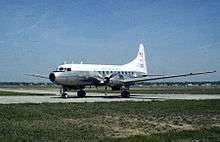
- HC-131A
- 52-5794 – On display at the Pueblo Weisbrod Aircraft Museum in Pueblo, Colorado.[13][14]
- C-131A
- 55-4757 – On display at the Minnesota Air National Guard Museum in Minneapolis, Minnesota.[15]
- C-131B
- 53-7811 – Last registered to Tatonduk Outfitters Limited in Fairbanks, Alaska. This aircraft was previously on display at the Kelly Field Heritage Museum, Lackland AFB, Texas.[16]
- 53-7819 - Active - [17] in private ownership with Airborne Resources Inc, Midlothian TX.
- 53-7821 – On display at the Air Force Armament Museum, Eglin AFB, Florida.[18]
- C-131D
- 54-2806 – On display at the Jimmy Doolittle Air & Space Museum, Travis AFB, California.[19]
- 54-2808 – On display at the March Field Air Museum, March ARB (former March AFB), Riverside, California.[20]
- 54-2810 – Stored at Burlington Air National Guard Base in Burlington, Vermont.[21]
- 54-2822 – On display at the Aerospace Museum of California, former McClellan AFB, California.[22]
- 55-0292 – On display at the South Dakota Air and Space Museum, Ellsworth AFB, South Dakota.[23]
- 55-0293 – On display at the Selfridge Military Air Museum, Selfridge Air National Guard Base, Michigan.[24][25]
- 55-0294 – On display at The Leonardo (Salt Lake City) Salt Lake City, UT.[26]
- 55-0295 – On display at the Air Mobility Command Museum, Dover AFB, Delaware.[27]
- 55-0300 – On display at the Hill Aerospace Museum, Hill AFB, Utah.[28]
- 55-0301 – Cockpit only with unknown owner in Kenosha, Wisconsin. This airframe was previously on display at the National Museum of the United States Air Force, but was scrapped before 2009.[29][30]
- C-131F
- 140996 – In active service as N351FL. Flying nightly from Phoenix Sky Harbor International to California and back, as of January 2017 with GULF & CARIBBEAN CARGO INC.[31]
- 141008 – In active service as N345GS. Flying frequently in the Bahamas and Florida region with CONQUEST AIR INC. This company operates 4 additional C-131F aircraft.[32]
- 141013 – On display at the Yanks Air Museum in Chino, California.[33]
- 141015 – On display at the National Museum of Naval Aviation, NAS Pensacola, Florida.[34]
- 141017 – On display at the Pima Air & Space Museum in Tucson, Arizona.[35]
- 141025 – In storage at the Pima Air & Space Museum in Tucson, Arizona.[36]
- NC-131H
- 53-7793 – On display at the National Museum of the United States Air Force in Dayton, Ohio.[37][38]
- T-29A
- 49-1934 – On display at Sheppard AFB, Texas.[39]
- 50-0190 – On display at the Strategic Air and Space Museum in Ashland, Nebraska.[40]
- T-29B
- 51-7906 – On display at the Pima Air & Space Museum in Tucson, Arizona.[41]
- T-29C
- 53-3489 – On display at the 12th Flying Training Wing area, Randolph AFB, Texas.[42] (previously displayed at former Mather AFB, California; disassembled and relocated following BRAC closure of Mather AFB)
- 52-2275 - On display at the Dyess Air Force Base Linear Air Park, Abilene, Texas. This aircraft was originally delivered to the United States Air Force on October 26, 1954 serving as a navigation trainer at Harlingen Air Force Base, Harlingen, Texas, and then it was reassigned to Connally Air Force Base, Texas. It served at these two bases from March 1960 to October 1965, Then was transferred to the U.S. Navy. The aircraft was retired from U.S. Navy service in March 1975. SEE: ref: Pg. 199, "The History of Dyess Air Force Base - 1941 to the present", by Lt. Colonel George F. Larsen, USAF (RETD) Schiffer Publishing Company, ,4880 Lower Valley Road, Atglen, PA. 19310, printing date:2016.
Specifications (C-131B)
Data from United States Military Aircraft since 1909[43]
General characteristics
- Crew: four
- Capacity: 48 passengers
- Length: 79 ft 2 in (24.14 m)
- Wingspan: 105 ft 4 in (32.11 m)
- Height: 28 ft 2 in (8.59 m)
- Wing area: 920 sq ft (85.5 m2)
- Empty weight: 29,248 lb (13,294 kg)
- Max takeoff weight: 47,000 lb (21,363 kg)
- Powerplant: 2 × Pratt & Whitney R-2800-99 "Double Wasp" 18 cylinder air cooled radial engines, 2,500 hp (1,865 kW) each
Performance
- Maximum speed: 293 mph (472 km/h, 255 kn)
- Cruise speed: 254 mph (409 km/h, 221 kn)
- Range: 450 mi (725 km, 391 nmi)
- Service ceiling: 24,500 ft (7,470 m)
- Rate of climb: 1,410 ft/min (7.2 m/s)
See also
Related development
Aircraft of comparable role, configuration and era
Related lists
References
- Notes
- "T-29 / C-131". www.uswarplanes.net. Archived from the original on 24 July 2017. Retrieved 26 March 2018.
- Gradidge 1997, p. 20–21.
- "Mercury Astronauts in Weightless Flight on C-131 Aircraft". 2006-08-02. Retrieved 2016-05-14.
- "Mercury Astronauts in Weightless Flight on C-131 Aircraft". NASA on the Commons. 1959. Archived from the original on 2016-11-08.
- How The Vomit Comet Works – Convair C-131 on YouTube
- "Project Tailchaser". Archived 2011-12-04 at the Wayback Machine globalsecurity.org. Retrieved: 21 July 2011.
- Jack S. Ballard Development and Employment of Fixed-Wing Gunships 1962–1972 Archived 2011-07-11 at the Wayback Machine. Office of Air Force History. 1982
- Accident description for ASN Aircraft accident Convair C-131D (CV-340) 55-0291 München at the Aviation Safety Network
- "Accident: Conquest Cargo CVLP near Miami on Feb 8th 2019, both engines failed, forced landing in sea". 2019-02-08. Retrieved 2019-02-09.
- Wegg 1990, p. 190.
- "Old plane retired." Dayton Daily News. Retrieved: 21 July 2011.
- Andrade 1982, p. 176
- "Actual Aircraft on Display in Pueblo". Pueblo Weisbrod Aircraft Museum. Archived from the original on 25 December 2016. Retrieved 24 August 2016.
- "Airframe Dossier – Convair CV-240/340/440/580/600/640 / C-131 / R4Y / T-29, s/n 5794 USCG, c/n 53-14, c/r N3999P". Aerial Visuals. AerialVisuals.ca. Archived from the original on 6 October 2016. Retrieved 24 August 2016.
- "Convair C-131H Samaritan." Archived 2016-03-04 at the Wayback Machine Minnesota Air National Guard Museum. Retrieved: 30 July 2015.
- "Airframe Dossier – Convair C-131B Samaritan, s/n 53-7811 USAF, c/n 340-263, c/r N2034L". Aerial Visuals. AerialVisuals.ca. Archived from the original on 6 October 2016. Retrieved 24 August 2016.
- https://flightaware.com/resources/registration/N131CR
- "Airframe Dossier – Convair C-131B Samaritan, s/n 53-7821 USAF, c/n 340-273". Aerial Visuals. AerialVisuals.ca. Archived from the original on 6 October 2016. Retrieved 24 August 2016.
- Veronico, Nick. "Outdoor Exhibits – C-131D "Samaritan"". Travis Air Force Base Heritage Center. Travis Heritage Center. Archived from the original on 5 June 2015. Retrieved 24 August 2016.
- "C-131D Samaritan". March Field Air Museum. March Field Air Museum. Archived from the original on 31 May 2016. Retrieved 24 August 2016.
- "Airframe Dossier – Convair CV-240/340/440/580/600/640 / C-131 / R4Y / T-29, s/n 54-2810 USAF, c/n 340-207". Aerial Visuals. AerialVisuals.ca. Archived from the original on 14 October 2016. Retrieved 24 August 2016.
- "Convair VC-131D Samaritan". Aerospace Museum of California. Aerospace Museum of California. Archived from the original on 17 April 2016. Retrieved 24 August 2016.
- "Airframe Dossier – Convair C-131D-CO Samaritan, s/n 55-0292 USAF, c/n 340-315, c/r N8435H". Aerial Visuals. AerialVisuals.ca. Archived from the original on 2016-03-25.
- "C-131D Samaritan". Selfridge Military Air Museum. Selfridge Military Air Museum. Archived from the original on 18 August 2016. Retrieved 24 August 2016.
- "Airframe Dossier – Convair C-131D Samaritan, s/n 55-0293 USAF, c/n 440-316, c/r N8436H". Aerial Visuals. AerialVisuals.ca. Archived from the original on 6 October 2016. Retrieved 24 August 2016.
- "C-131D Samaritan". The Leonardo Museum. The Leonardo Museum. Archived from the original on 20 December 2016. Retrieved 12 December 2016.
- "C-131D Samaritan". Air Mobility Command Museum. AMC Museum Foundation, Inc. Archived from the original on 30 April 2016. Retrieved 24 August 2016.
- "C-131D "Samaritan"". Hill Air Force Base. 27 September 2007. Archived from the original on 11 September 2016. Retrieved 24 August 2016.
- "Airframe Dossier – Convair C-131D-CO Samaritan, s/n 55-0301 USAF, c/n 440-329, c/r N8443H". Aerial Visuals. AerialVisuals.ca. Archived from the original on 6 October 2016. Retrieved 24 August 2016.
- "Vintage Transports, photos by Friends & Guests". RuudLeeuw.com. Archived from the original on 14 June 2016. Retrieved 24 August 2016.
- "Aircraft Data N351FL, 1955 Convair C-131F (R4Y-1) Samaritan C/N 279". www.airport-data.com. Archived from the original on 27 March 2018. Retrieved 26 March 2018.
- "FAA REGISTRY". Retrieved 2019-12-09.
- "Convair C-131F Samaritan". Yanks Air Museum. 2017-01-28. Retrieved 2019-12-26.
- "C-131 Samaritan". National Naval Aviation Museum. Naval Aviation Museum Foundation. Archived from the original on 30 August 2016. Retrieved 24 August 2016.
- "Samaritan". Pima Air & Space Museum. PimaAir.org. Archived from the original on 6 October 2016. Retrieved 24 August 2016.
- "Airframe Dossier – Convair C-131F Samaritan, s/n 141025 USN, c/n 340-308, c/r VH-EAQ". Aerial Visuals. AerialVisuals.ca. Archived from the original on 6 October 2016. Retrieved 24 August 2016.
- "Convair NC-131H Total In-Flight Simulator (TIFS)". National Museum of the US Air Force. 9 October 2015. Archived from the original on 11 September 2016. Retrieved 24 August 2016.
- "Airframe Dossier – Convair NC-131H Samaritan, s/n 53-7793 USAF, c/n 340-245, c/r N793VS". Aerial Visuals. AerialVisuals.ca. Archived from the original on 6 October 2016. Retrieved 24 August 2016.
- "Airframe Dossier – Convair GT-29A Samaritan, s/n 49-1934 USAF, c/n 240-201". Aerial Visuals. AerialVisuals.ca. Archived from the original on 25 March 2016. Retrieved 24 August 2016.
- "T-29A "Flying Classroom"". Strategic Air Command & Aerospace Museum. Strategic Air Command & Aerospace Museum. Archived from the original on 1 August 2016. Retrieved 24 August 2016.
- "Flying Classroom". Pima Air & Space Museum. PimaAir.org. Archived from the original on 6 October 2016. Retrieved 24 August 2016.
- "Airframe Dossier – Convair T-29C Samaritan, s/n 53-3489 USAF, c/n 240–443". Aerial Visuals. AerialVisuals.ca. Archived from the original on 6 October 2016. Retrieved 24 August 2016.
- Swanborough and Bowers 1969, p. 150.
- Bibliography
- Andrade, John. Militair 1982. London: Aviation Press Limited, 1982. ISBN 0 907898 01 7.
- Frawley, Gerald. "Convair CV-540, 580, 600, 640 & CV5800", The International Directory of Civil Aircraft 1997/98. Fyshwick ACT: Aerospace Publications, 1997. ISBN 1-875671-26-9.
- Gradidge, Jennifer. The Convairliners Story. Tonbridge, Kent, UK: Air-Britain (Historians) Ltd, 1997. ISBN 0-85130-243-2.
- Swanborough, F. G. and Peter M. Bowers. United States Military Aircraft since 1909. London: Punam, 1963.
- Wegg, John. General Dynamics Aircraft and Their Predecessors. London: Putnam, 1990. ISBN 0-85177-833-X.
External links
| Wikimedia Commons has media related to Convair C-131 Samaritan. |
- Convair 240 – National Air and Space Museum
- C-131 Samaritan factsheet – National Museum of the United States Air Force
- C-131D Samaritan – March Field Air Museum
- C-131 Samaritan – GlobalSecurity.org
- C-131 Samaritan – The Aviation Zone
- Gunships – The Aviation Zone